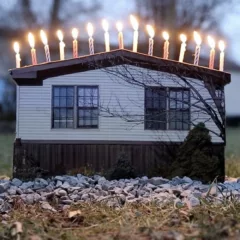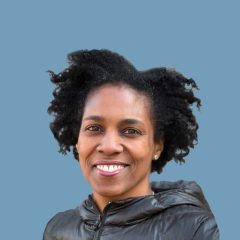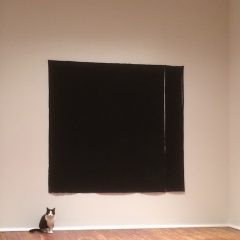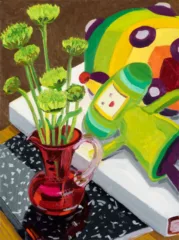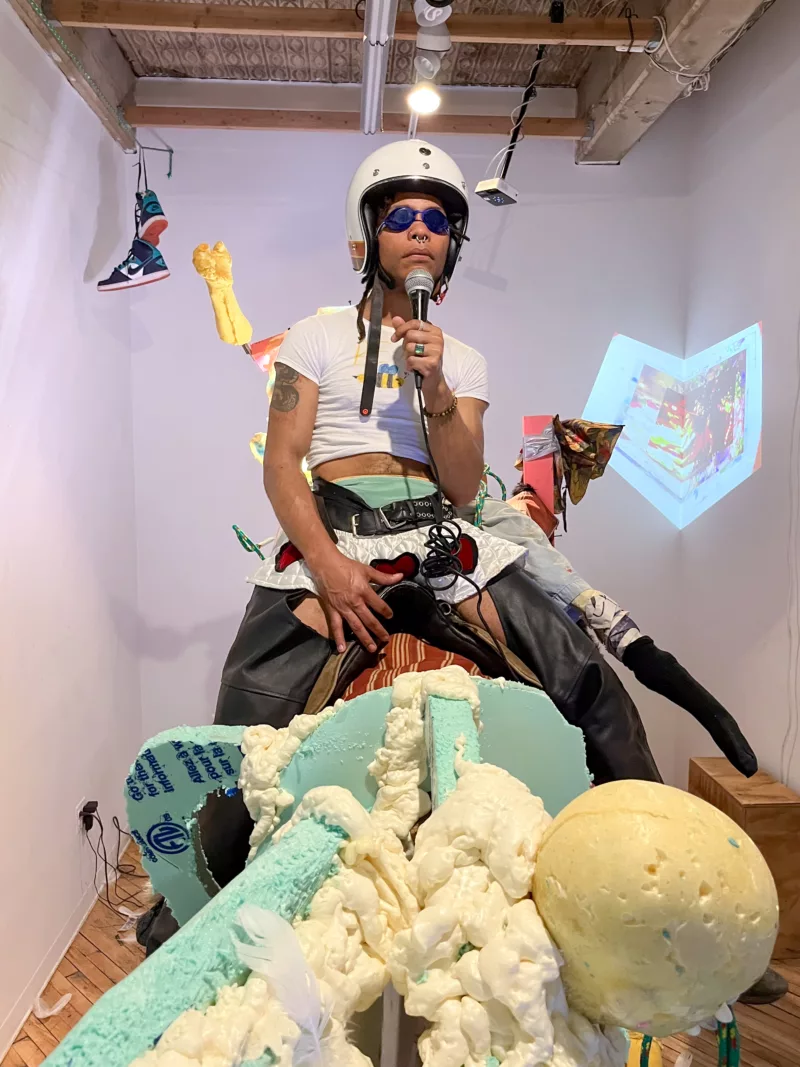
Author’s Preface
I met with five members of Grizzly Grizzly on Zoom, at the time when they had just deinstalled the show by David Herbert and were prepping the next exhibit, Freed from Necessity, a two-person show featuring the work of Philadelphia-based sculptor Matthew Speedy and interdisciplinary artist Halo Lahnert. Grizzly members Erin Boyle, Amy Hicks, Diedra Krieger, Connor Longo and Jayne Struble participated in the conversation.
Elizabeth Johnson: Many of you teach or have other jobs apart from the gallery, Family, your own art practice: How do you balance multiple responsibilities?
Amy Hicks: As the current longest running member, teaching full time at the University of Delaware, with family and my own art, it’s a balancing act. I make time for Grizzly Grizzly since it is an essential creative and social part of my life. We operate with six people, so if one of us is feeling pinched or traveling, someone else is always there to pick up the pieces. That is one of the meaningful parts of a collective–being there for each other and for the art community at large. Participation waxes and wanes over the years but we are all very dedicated. We have meetings once, maybe twice a month on Zoom and staff First Friday openings. We have a regular list of tasks that we divide amongst each other, and we share installing shows and posting to social media. We also share gallery sitting and planning with other artist collectives on the floor.
Connor Longo: We keep as many things in the air as we can without going crazy. Multiple people step up. I’ve been a member for a year; it’s something that I can bring to my art students.
Jayne Struble: As the newest member and an art professor, working with Grizzly Grizzly is something I prioritize. Curatorial practice influences my own practice as much as research. Achieving a balance makes an important example for my students.
Erin Boyle: I tend to perform better when I have a lot of tasks to complete. In the past, I was heavily involved in the art scene in Philadelphia. However, when I began teaching at only one institution, I felt isolated. Joining Grizzly Grizzly has given me the opportunity to meet new artists and regain my sense of community.
Elizabeth: Do your art students participate at the gallery?
Amy: Yes, Grizzly Grizzly has always been open to student field trips and tours and often invites previous (and current) students to intern. Our interns attend meetings, gallery sit, and help with show installation. We also ask them to pick a longer-term project they would want to work on such as promotion or redesigning a part of our website, or even curating a one-night event. They learn about communicating with artists and running an alternative art space.
Elizabeth: Why do you always have six people?
Amy: Any more is too many. We’re looking for a new member to replace Ephraim Russell who just stepped down; he gave us four to five months’ notice. Six people allows us to pay fifty-five dollars each to cover rent (the rent was just raised ten dollars for the first time in fourteen years) with no additional fundraising events. I don’t like fundraising, it’s not the conversation I want to have. I just want to work with artists.
Elizabeth: Besides members paying rent, how else do you support the gallery financially?
Amy: We sell work on occasion, seventy percent goes to the artist, we take thirty percent. But as we are not a commercial gallery, this is rare. We also occasionally apply for grants. We have received awards from the Knight Foundation and the Velocity Fund. The Velocity Fund supported a ten-year anniversary book of essays about Grizzly Grizzly. Roberta Fallon wrote the introduction about the current state of artist collectives in Philadelphia and previous member Cindy Stockton Moore wrote about the history of Grizzly Grizzly from 2009-2019. With the support from Velocity Added, which we received just months before the pandemic, we tried hosting on-line events and openings and created the 319 Artist-in-Residence Program with the other collectives on our floor. It was a beautiful moment of collaborative effort with Marginal Utility, Pink Noise Projects, Automat, and Practice. For the first time we were able to pay for promotional ads on Artblog to spread the word about submissions. Jayne was one of our residents, and now she is a new member.
Jane: My residency happened in the first six months of 2021, I had lost my studio and office space and was living with my parents. It was perfect timing, and it coincided with a big snowstorm, so I did a lot of new work incorporating the space and snow.
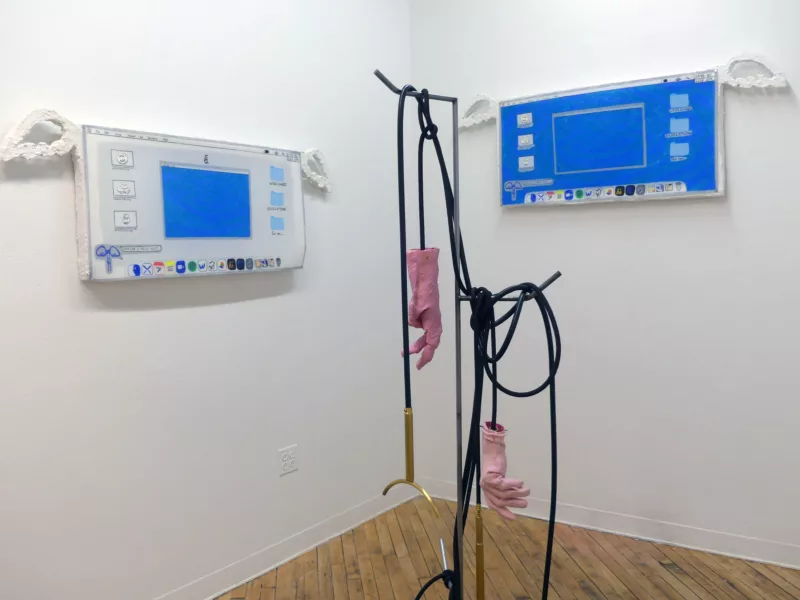
Elizabeth: On the Grizzly Grizzly website, the About section states: “We are all practicing artists who also curate exhibitions, performances and alternative programming. . .we create a meeting ground for dialog and a space for innovative work without the constraints of institutional agendas or commercial interests.” How has the mission changed over the years?
Amy: The Mission Statement was there when I joined in 2014, I’m not entirely sure who wrote it, but it still applies. Michael Ellyson first rented the space as a studio until he discovered how hot it was in the summer and started using it as an exhibition space. While he gave Grizzly Grizzly its name, I don’t think he intended it to last. The second wave: Mary Smull, Cindy Stockton Moore, Ruth Scott Blackson, and Jacque Liu probably wrote the mission statement around 2010 (my guess). I came as part of the third wave, not knowing much about the people before me. Dialog and supporting artists are still at our core. And though I wouldn’t necessarily call myself a curator, we like to experiment with unusual artist pairings. We all bring artists to the table. And as with TSA, no one person is in charge, so we aren’t assigned, but take different months to showcase artists or ideas that we are interested in.
Connor: For example, Diedra Krieger and I came across the work of Halo Lahnert at a Temple MFA show, and Erin brought in Matthew Speedy. We throw out ideas and work organically through dialog to assemble a show. We always aim to bring an exhibit that activates the space. The best shows seem to be when two members suggest artists, and then one artist-member takes the lead to make it happen. Visualize a machine: pieces come in and parts come out; what we’ll make is not known beforehand, but it usually works.
Erin: I joined last January; it was what I needed to have happen in my life. Grizzly Grizzly is an open support system, that is easy to start contributing to, and step away from. The following quote from our ten-year catalog expresses it best: “We work as artists with artists to engage in dialog with each other and those who visit the space.”
Jane: I joined last month after I moved back to Philly. Grizzly Grizzly has always spoken to me, since I look for art that doesn’t necessarily have a price tag. I felt I could step into the conversation in the room. Now that I’m a member I’m struck by how much we talk things through; for instance, defining what it means to be a curator. It takes conversation to absorb the breadth of different perspectives.
Elizabeth: Your website About section goes on to say, “We do not strive for consensus: we do not show our own work in the space.” How do you feel about not showing yourselves?
Amy: After working in non-profit artist spaces in San Francisco such as Southern Exposure and Capp Street Project, I found Philadelphia artist-run spaces perplexing since it appeared that artists were paying to show their own work, a pay-to-play sort of thing. I realize, of course, that in our current economic climate and our nation’s ill-support of art and artists, DIY spaces provide a pipeline to local, mid-career, and emerging artists. And while Grizzly Grizzly members do show off-site together occasionally: we’ve exhibited at Arlington Art Center, Esther Klein Gallery, Cedar Crest College, and, coming up, at the University City Arts League. To me, the most important act is finding creative ways to support artmaking. I am doing this as an artist; it is also my creative work.
Connor: I grew up here, so artists showing themselves was normal, but not doing so is what makes Grizzly Grizzly different. Focus is not on me, but on how we frame Philadelphia artists for an audience. There’s still a little bit of me in there, and it feels good to be assisting someone else’s vision. Looking at other artists’ work affects what I want to see when looking at my own, it’s a helpful cycle. Of course, there are times when I would like to show, but it’s a discipline not to.
Erin: Grizzly Grizzly appealed to me because I am more effective in promoting local artists and fostering connections when I am not showcasing my own work. It allows me to collaborate with others to bring a shared vision to life.
Elizabeth: How would you describe the Grizzly Grizzly aesthetic? I get a science-y, wonky feel from your exhibits.
Amy: That is an elusive quality and hard to describe; the aesthetic is dependent on our members at any given time. Perhaps it’s a continuum, since artist-members reproduce themselves in a way; members join who are attracted to the work shown and then curate shows that are in line with previous members’ tendencies. We do have a history of edgier shows that consider the relationship between humans and technology. For example, Surfacing paired Adriane Colburn who relates systems and human-made structures to the environment and Nichola Kinch who uses process as material. I had wanted to show Adriane’s work for some time and then Diedra mentioned Nichola and it clicked.
Elizabeth: Does curation push boundaries that your own work wouldn’t?
Amy: Yes, the act of seeing and selecting others’ work engages my brain and empowers me to think differently…I’m curious, Connor’s work pushes boundaries by asking who is allowed to have power. Connor, how does curation relate to the work you are making?
Connor: I think about human interaction in the world, how we imagine and use institutional space. But there is still a barrier between my work and the artists we curate. I can’t do what you do, but we have commonalities.
Jane: I haven’t curated a show yet for Grizzly Grizzly. But I hosted openings once a month in a pop-up space I co-directed using my living room in Florida, presenting work for friends and students, since there were zero galleries in the area. I worked with technology and websites in that space. Now I work with how technology accesses nature. I know how difficult it can be to find spaces willing to show experimental work, so like Connor, I like to provide space to show risky work that maybe some galleries wouldn’t show.
Erin: I like hearing people’s perspectives today. I have both public and private work. As my personal, more technological work is not widely known, I appreciate artists who take risks and use technology to engage with current events. I don’t always start conversations correctly, but I’m good at joining one. I live in suburbia with three kids, where conversations about art are limited to the familiar. Grizzly Grizzly enables me to seek a dual aesthetic.
Diedra Krieger: Absolutely. I lined up cybernetic artists London Tsai and Wen-Ying Tsai to show at Grizzly Grizzly. Through my job, I reached out to Amy Laviers who runs RadLab about an exhibition series on art and robotics to coincide with ICRA (International Conference on Robotics and Automation). I also sought to collaborate with other collectives on the second floor to invite artists working in technology and robotics, building on cooperation fostered through the 319 Artist in Residence program during the pandemic. We hosted additional programming and received over two hundred robotics researchers as visitors to our spaces.
Elizabeth: Did Grizzly Grizzly’s support of the PAFA student BLM demonstrations affect you personally or professionally?
Amy: Of the members here, I was the only member around at that time. The PAFA students came to us seeking an alternative space for their thesis work while they boycotted PAFA, and we allied with them because GG has a history of supporting artists expressing their political ideals. I think of universities as a space for free thinking and didn’t even consider personal or professional consequences. I don’t think the PAFA demonstration was on University of Delaware’s radar, but if students protested there, I would support them and feel confident that UD would support me.
Elizabeth: Does Grizzly Grizzly give you freedoms that the University does not?
Amy: Yes and no. Perhaps one of the biggest differences is that university spaces are weighed down by bureaucratic systems and advanced planning, making it hard to act spontaneously. Grizzly Grizzly is small, nimble, and can ally with artists to respond to timely issues. The small space makes materials for a solo show more affordable for an emerging artist. We show artists operating outside institutions, yet we still need academic spaces.
Connor: MFA shows around Philadelphia allow students to speak their minds, but there’s a lack of venues supporting artists outside academia. We are in line with content at some universities as more conservative content seems to be waning. Grizzly Grizzly allows us to push the envelope.
Jane: We love that artists can take over our space inexpensively.
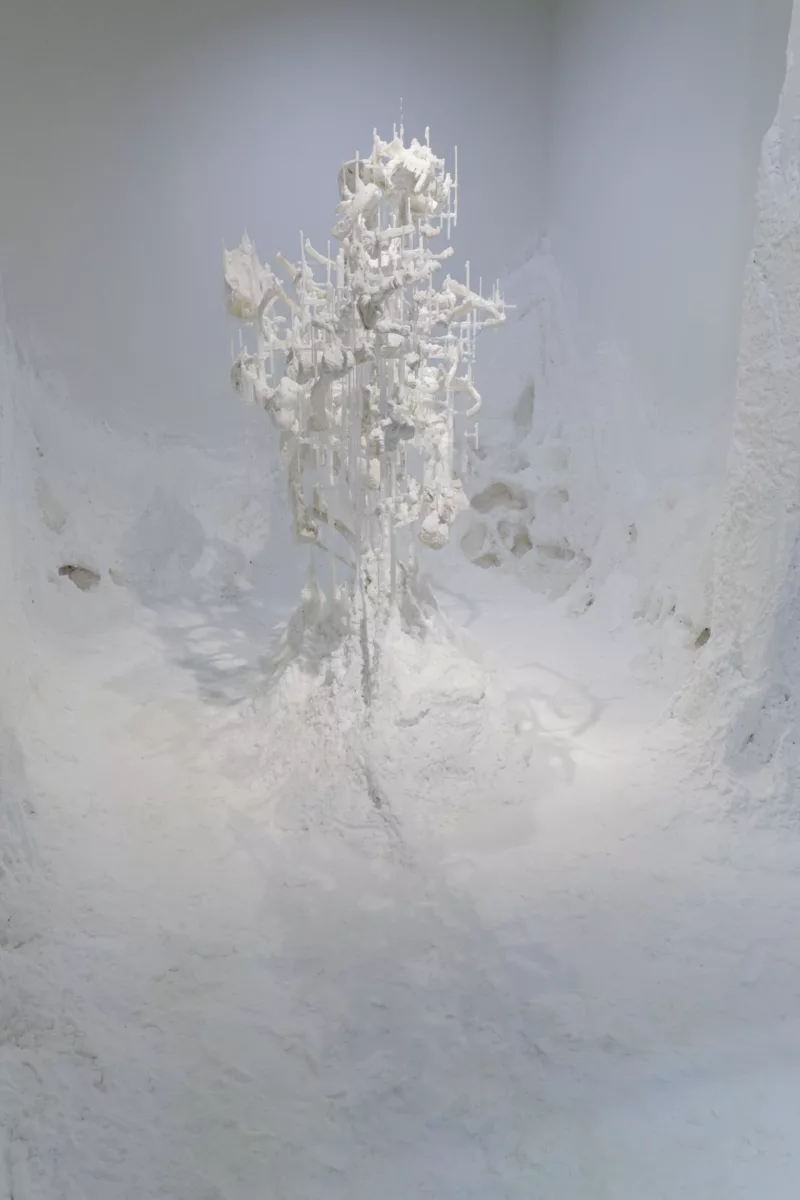
Elizabeth: Do you plan with the artists, or do they propose shows?
Amy: Mostly we plan with the artists, but some artists come in knowing precisely what they want to do. For example, Jonathan Latiano planned a complete, room-sized salt installation that he had never been able to do in larger spaces. David Herbert looked at our space and sent us a specific model. On the other hand, Nichola and Adriane’s process was more organic. We had multiple conversations and moved stuff around together to accommodate both bodies of work while emphasizing the exchange between the works. And Jordan Deal responded directly to the space without us knowing exactly what they were going to do. We offered them the space to experiment.
Erin: Grizzly Grizzly’s space is ideal for showcasing large-scale works that can transform the area. Unlike institutional galleries that may require walls to be built to display such pieces, our smaller floor plan offers the perfect setting to create tension with big pieces in small spaces. However, we don’t limit ourselves to just showcasing this type of work. Each exhibition is approached in a unique way, with our team selecting, collaborating, and working closely with artists to create engaging conversations within the space.
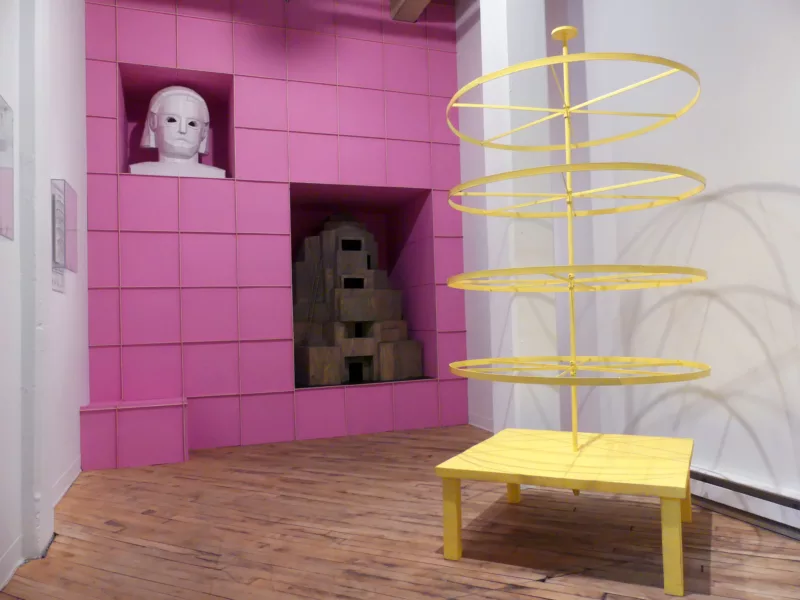
Elizabeth: How big is the gallery?
Amy: Just under 200 square feet. And we have that weird pillar in the middle to work around.
Connor: Nichola made a cool table for her sculpture that bent around the pole.
Elizabeth: Are openings packed?
Amy: Yes, you can only fit so many in Grizzly Grizzly!
Connor: People tend to gather in other spaces but cycle through ours. It’s a blessing and a curse.
Elizabeth: How do you manage not to get overwhelmed by submissions?
Amy: We’ve always had open submissions and sort through them once a year. Most of our shows are by invitation. But we don’t want to be the only ones finding people. We want people to send us ideas for shows so we learn what we don’t know. Our annual exhibit Hot August Nights is a new opportunity to solicit video submissions. It came about because our space is an interior space that has no windows and August is too hot for any artist to install their work.
Elizabeth: Looking to the future, money aside, what would you like to see happen for the space?
Amy: I’d like to build more connections with writers. Our blog Speak Speak allows writers to respond to the shows, and therefore, a virtual document lives beyond the actual timeline of lived space. I’d also love to do a book about the second-floor artist collectives to capture this fleeting moment. Maybe collaborate with artist-run spaces nationally. We were part of Common Field before it shut down. That national organization gave us the opportunity to partner with the Living Room Light Exchange (San Francisco, CA), Ulises (Philadelphia, PA) and ‘syndikit (Baltimore, MD). [Ed.note about sindikit… ‘sindikit (correct spelling) is an artist project that ran from 2016-22, co-created by artists Zoe Charlton and Tim Doud.]
Connor: We need to bring in more diverse media and methods. We could do more to digitally partner with other similar spaces.
Elizabeth: Do you have a closet of TVs?
Connor: We have a shopping cart that is full of equipment. Amy keeps monitors at her house. Storage and lack of equipment is one of our challenges. Though most artists provide their own technology, or we borrow it.
Jane: I feel like Speak Speak is working; our future is about dialog. I like the idea of podcasts or conversations with the artists.
Amy: Diedra Krieger has just started making short videos with artists of current shows.
Erin: The question at hand is how we can broaden our conversation to reach beyond our typical audience. I believe utilizing social media and virtual exhibitions would add depth to the space. Additionally, I find the concept of surveillance intriguing.
Amy: In-person socializing is so important for artists. We would have to build remote conversation into something real because it is hard to get people interested in a solely virtual event. In the past we have partnered with Venture Cafe for online artist talks and tried platforms like Remo and ISSUU for online engagement.
Elizabeth: What would you do if the gallery received a million dollars?
Amy: We thought of becoming larger after the 2017 fire in the stairwell that closed all the artist spaces in Building 319 for six months. Several artist collectives moved out and we considered moving to a larger space. But ultimately, we decided we like our size. I often wonder what would happen to Grizzly Grizzly if the building were to sell. We could get a truck the size of the gallery and drive around, something more ephemeral.
Connor: I would hire employees who could assist with social media. And fund the artists and writers. It would be a great incentive for commitment.
Jane: It would be nice to secure the building indefinitely, as a place that could be used to exhibit art and house studios. It would be awesome to offer free studio residencies to bring more artists to the area.
Elizabeth: A million might be a good down payment.
Amy: We could commission residencies and pay writer fees. I would love to hire lobbyists to advocate for artists, art publications and reviewers in Philadelphia.
Erin: I would love to see more artists rotating through the space and the potential to give them the proper funding to create their vision.
Connor: Vox [Populi] downsized, but that made room for Novella, Blah Blah, and Fuller Rosen Gallery to move in.
Amy: I feel like we need to make the space more accessible to larger populations. We are so privileged to be able to run a space. We have jobs and can pay fifty-five dollars a month.
Though I believe larger institutions should take on more responsibility for showing local artists, we are so lucky to be here.
Visit Grizzly Grizzly at their website. And visit the gallery in person at 319 N. 11th St., 2nd Floor, Philadelphia, PA 19107.


